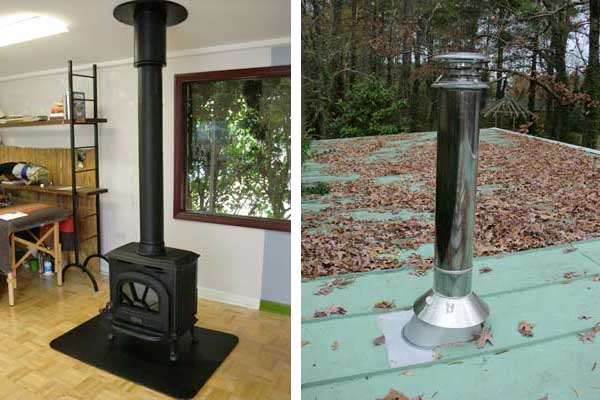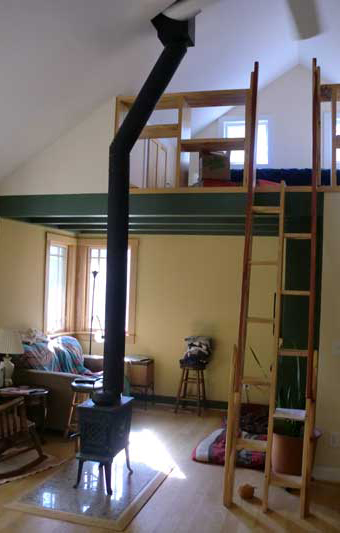Why Hiring A Professional To Install Your Wood Stove Is The Right Thing To Do
Installing a wood stove in your house can be a wonderful decision for improving your overall atmosphere and heating energy efficiency in your home.
Hopefully, you have looked at all the parameters: venting system placement, vent system compatibility, the height of the chimney system, proper clearance, size and floor protection. If not, then it is time to call in someone who has the experience, skill and technical knowledge needed to get this project moving in the right direction. That’s where we come in. Fire Safe Chimney Sweep is a competent specialist when it comes to anything concerning your hearth. The first and most important part of the process is determining the type of chimney system you have.
Why the Chimney is Critical
Since every wood stove needs to be vented in some way, you must make sure that you have a sound masonry chimney or a UL approved Stainless Steel Class “A” Insulated Chimney. If you plan on running a stovepipe through a window, wall or roof you need to think again: there are certain building and safety codes one must follow first.
The most popular option for new stove installation is the Class “A” Insulated Chimney. The configuration of the chimney will be different for every home because the layout, levels and building materials used for your home are different from the Jones’ house down the street. Codes can also be different from county to county.

Short Checklist
- Use only UL Approved Chimney
- Stovepipes cannot pass through Walls, Ceilings, or Floors without proper clearances and never out through Windows
- The taller the chimney, the better the draft
- A chimney with the fewest bends will have the best draft
- The chimney should extend 2 feet above anything within 10 Feet or 3 feet above peak
- Plan on using a chimney cap to prevent birds and other small animals from entering
The Problem with Masonry Chimneys
Do you know that 80-90% of the masonry chimneys in the US are either constructed improperly or not up to current standards and codes? Many have draft issues from not being insulated or maintained properly so creosote buildup is a problem. Not having the proper clearances for proper fuel combustion is also an issue with both older AND newly constructed chimneys! It sounds crazy but it is true. Another issue that can arise when adding an appliance is that the current masonry chimney has no room for expansion.
If the masonry chimney is being constructed, all of these things can be easily addressed. However, if it is an existing chimney, it will have to be brought up to current codes. Most of the time when customers are interested in having a wood stove installed, they will be looking at adding a UL Approved Stainless Steel Liner as well.
Things To Remember When Using a Masonry Chimney
- The flue chimney liner should be a bit larger than the size of the stovepipe
- The chimney should be inside the building if at all possible and insulated
- If using an existing masonry chimney, there is a good chance that it will need to be relined with a UL approved stainless steel pipe
Liner vs. Stovepipe
A liner will be used when installing an insert.
It connects to the appliance then runs up through the chimney. Stovepipe is used when installing a hearth stove or a free-standing stove. Similar to a liner, it also connects to the appliance. In the instance of a hearth stove, the stove pipe vents out through a chimney; for a free- standing stove, the stovepipe vents directly out the roof. There are two kinds of stovepipes. The single wall stove pipe has one layer and is designed to connect a wood stove to a nearby chimney. The close clearance stove pipe has two walls, a stainless steel inner wall, and a black painted outer wall. The space between the walls is an insulating layer. This allows it to be up to six inches from combustibles and is designed to be used only inside.

Best Materials To Place Underneath Your Stove
If you have ever seen a floor that has been burned from a stove, you will understand why it is very important to protect the floor where your stove will be placed. Several options are acceptable for the kind of heat that it will need to withstand. They are:
- A concrete slab works great even bare but can also be as good with tile or brick
- Pre-Fab UL Approved Stove Boards and Mats to put down before you set the stove
- Ceramic Tile, Marble or Slate installed on top of UL Listed cement board
The key is to have a noncombustible floor or base underneath the stove. Check with the manufactures specifications for the minimum of inches of flooring that should be around all sides of the stove and in front of the doors. Also, don’t forget about placing the flooring underneath and horizontal to the run of the stove pipe connection to the chimney as that should be protected from the heat as well. We can help determine what size board you will need, and we have several styles available.
For The Walls Around The Wood Stove
Again, check with the manufactures specifications to see what the safe distances are from combustible walls for installation. A professional chimney company, like us, can help you with this. There are ways to reduce this distance but you do need to check with current building codes in your area to make sure these are acceptable.
- Installation of an approved non-combustible protection cover on the wall
- Installation of a specially designed rear heat shield on the stove
Contact us today!
Replacing damaged chase covers is just one installation on chimney systems that we do often.
